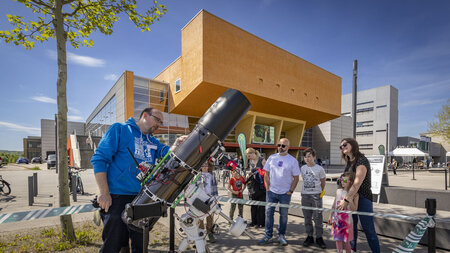Informatik-Kolloquien
312. Informatik-Kolloquium
Öffentliche Verteidigung im Rahmen des Promotionsverfahrens
Herr Dharshan Krishna Murthy, M.Sc.
TU Chemnitz
Fakultät für Informatik
Professur Rechnerarchitekturen und -systeme
"Emergency Braking in Compact Vehicle Platoons: A Cyber-Physical Design"
Mittwoch, 17.03.2021, 09:00 Uhr, per Videokonferenzsystem
Abstract:
- The existing inter-vehicle separations in close distance driving arrangements or platoons can be further reduced to below 5 meters (to maximize the benefits) without compromising on safety, especially, when braking in an emergency.
- At such short separations, the space buffers (B) in the inter-vehicle separations can be efficiently utilized to minimize the overall stopping distance of the platoon. In this direction, once emergency braking is initiated, vehicles have to track their respective reference decelerations computed using our approach.
- The computations of our Space-Buffer approach rely on stopping distances of vehicles from a common cruise velocity. The controller-related effects (i.e., rise time, settling time, etc.,) in tracking a reference deceleration impact a vehicle's stopping distance. Since these effects are neglected by the standard expression of stopping distance, the same cannot be used. Hence, an expression that computes a vehicle's stopping distance under controller action was derived, and the resulting stopping distance values were used in our approach.
- The road profile transitions the vehicles undergo during emergency braking impacts safety. Some controllers cannot counter the (disturbing) grade force in a downhill (as they are already braking at their limit on a flat road to minimize the overall stopping distance). As a result, they incur actuator saturation and fail to continue tracking their assigned decelerations. In such situations, through a distress message broadcast, and our proposed coordination scheme we ensure vehicular collisions are avoided and a safe maneuver results, while simultaneously minimizing the overall stopping distance of the platoon.
- At 2 meters separations (B = 1 meter), our Space-Buffer approach results in the most benefits, obtaining the best trade-off between stopping distance, platoon length, and aerodynamic benefits in comparison to the intuitive (Least Platoon Length and Least Stopping Distance) and the Subplatoon approaches.
- At 3 meters (B = 2 meters) and 4 meters (B = 3 meters) separations, our approach achieves the optimum stopping distance. Even though at these separations, the platoon becomes longer and the aerodynamic benefits decrease when compared to B = 1 meter and the other approaches, the performance is significantly much better in comparison to platoons that employ separations of 5 to 10 meters and above.





